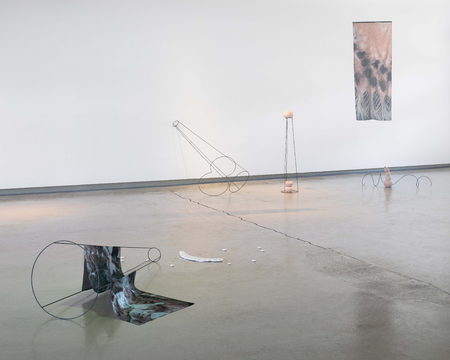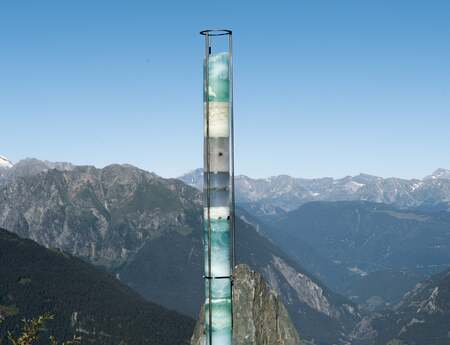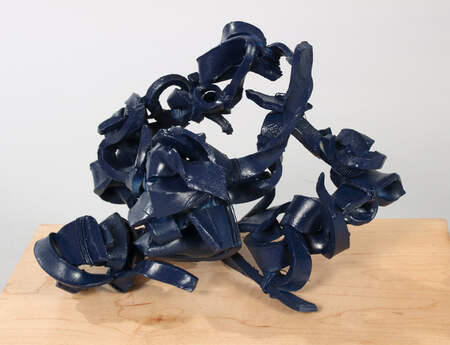Stockmeyerstr. 41 Halle 4J
20457 Hamburg
Deutschland
Luísa Telles - Uproot
Photography by Henning Rogge
Text by Christiany Erler
Luísa Telles is a Brazilian artist, independent curator and lecturer based in Germany. Her exhibitions, seminars and writings focus on questions around social memory and the body as a means of resistance. Telles recently exhibited in Hamburg at Hypercultural Passengers, Raum linksrechts, Hinterconti, Mom Art Space and Deichtorhallen Museum. Her latest teaching position (Leuphana University), article (Arts of The Working Class Journal), lecture (Royal Academy of Arts The Hague), podcast (HfbK Hamburg) and curatorial project (Raum linksrechts) revolved around feminist-decolonial readings within art history.
*1991, São Paulo, Brasil. Lives and works in Hamburg, Germany.
Opening: 15. Sept. 2021, 19 - 21 h
All Fruits Come from Flowers
When I pick up a fruit, I often look at it very closely, searching for any signs, any traces that could indicate resemblance to the former shape the fruit once had. All fruits come from flowers. Fruits are what previously were the ovaries of a flower. Morphed into flesh, sweet and juicy. Their ovules, the seeds that in fertile ground and under the right conditions germinate and grow into entire beings that, in time, give more flowers that become fruit that give seeds and on, and on, in a cyclical flow. This flow is no different for one fruit that attracted the attention of Brazilian artist, Luísa Telles: the gourd.
The gourd— which I call cuia—is a large, green, meaty fruit that sprouts directly from the trunks of its tree, the cuieira. Some cuia species also grow on vines, much like pumpkins, zucchinis, cucumbers and luffas. But why do I insist on calling the gourd a cuia? The word cuia is a term that comes from Tupi, one of many branches of numerous indigenous languages from South America. Generally a variable dependent on regional tradition, the use of the word cuia in here revives a memory that has been stuffed into a type of preserve. My use of the term summons origin.
Plants, fruits, preserves, memories, transformation, movement, transition, revival. These elements have regularly made an appearance in Telles’ work. Drawing from archives, Telles is preoccupied with translations of form and of meanings and is interested in what processes of transfer do to objects and to the cultures around them. Not one to work alone, Telles has formed a number of collaborative partnerships in the past years. She favors and believes in the exchange and the cross-contamination that arise from the trade of ideas.
Cuia
Not usually planted in order to be eaten, the cuia is a fruit of many practical purposes. It possesses a hard, impermeable shell that, when cured right, functions as bowl, as plate, as bottle, as cup, as container, as musical instrument, as fishing float, as water collector, as garment, as accessory. This carrier bag of food, of wine, of water, of nuts, of paint, of music, of bodies, of community, of life, is a contender for post of humanizing hero as proposed by Ursula K. Le Guin in The Carrier Bag of Theory Fiction. Documents produced by the first 1European emissaries sent to the Americas attest to the widespread use and the many applications of the cuia within the then newly encountered societies.
These descriptions, almost like historical receipts to Le Guin’s theory, place the cuia in an interesting position: studies of its DNA reveal that it originated on the African continent. It is noteworthy that the cuia was used in the Americas prior to the encounter with Europeans. For one thing, this indicates movement. It could either be that cuia seeds sailed on floating fruits carried by ocean currents across the world, or on boats of travelers who braved the seas over 10,000 years ago. Since this text is not an anthropological article, nor does it serve any particular scientific purposes, for us (you, me, this text and Luísa) what is relevant is that these seeds traveled many millennia ago, from Africa, to Asia, into the Americas.
Traveling Seeds
Legally speaking, the import and export of seeds and plants is a highly regulated activity. Seeds and plants that meet this destiny undergo drying processes prior to being internationally commercialized. Much like the cuia, they are cured. But, while means can be similar, ends are not. The curing process gives the cuia a new life and allows it to play an active role in the organization of the community around it. The curing process takes away the life of the imported plants that are sold at home décor shops in Europe. This preservation process to which the plant is submitted strips away any possibility of reproduction the imported plant had, confines it into the rank of ornament and enshrines it in exoticism.
During the first wave of the pandemic in 2020, Luísa found unusually large seeds and their pods, along with cuias and palm tree branches, all of which are naturally found in tropical territory, for sale in a German online shop for home décor. According to the shop, these items were said to have come from Brazil. Feeling homesick and with travel prohibitions making it impossible to remedy that, Luísa bought the dried plants.
Reflecting on the issues of the life and the death of the allegedly Brazilian flora she acquired, Luísa reproduced pods, seeds and cuias in porcelain. In this context, the gesture can be read as raising questions on movement, commerce, social and power relations and some of the conditions of these things. A layer that stands out is the one that brings up the question of fertility. This matter, which also concerns reproductivity, offers much potential in complicating the other layers present in the conception of the work and points towards questions of right to (self) agency and to life.
Strangely Delicate Plant in Sober Florentine Soil
Those seasoned in the discourse of art theory may well know that reproduction is a vast subject in the field. In fact, the seminal text, Das Kunstwerk im Zeitalter seiner technischen Reproduzierbarkeit from 1935 written by Walter Benjamin, opened up entirely new discussions during its time and beyond, not only regarding reproduction, but also authenticity, aura, and the aestheticization of politics. These debates posed great influence and weight to art's and theory's production in the West for the better part of the twentieth century. Benjamin was a philosopher concerned with beauty and aesthetics, with gestures, with pathos, with memory, with history, and worked within conventions that trace back to Hegel. This Benjaminian aura was significant to Telles’s early practice. As were the thoughts of art historian, Aby Warburg—in fact, part of what brought her to Hamburg was his library, better known as the Warburg-Haus.
Throughout her practice, Telles has expressed an interest in the archives. She has worked with collections of historical records that reflect on aspects of culture both from Germany and Brazil, paying particular attention to a living and breathing form of archive commonly known as botanical gardens. It was Telles’s engagement with this more classical approach to research that brought cultural tensions to her work when the jaded canon resisted having such an exotic flower living outside of the greenhouse for which it was designated.
Greenhouse
Gardening is an ancient activity found to have been practiced in many cultures around the world throughout history, from China to Egypt, from Greece to Mexico. But Telles is interested in one specific way of gardening, one where collections of remote plants from many parts of the world coexist in a totally controlled environments known as greenhouses.
In Europe, the botanical gardens of today emerged during the time of the Enlightenment, when they were grown in association with universities for medicinal and other scientific purposes. The development of this form of gardening in the seventeenth and eighteenth centuries goes hand-in-hand with the colonial expansions that were being implemented at the time. New technologies, greenhouses included, a llowed for the transplantation and 6 transportation of plants from distant origins, as well as their cultivation in an environment that would have otherwise been hostile to their existence.
Enter dissociation, desire, and utopia. In his book, Necropolitics, Achille Mbembe reflects on how cultural differences play a role in both the handling of objects and the symbolic statuses that are ascribed to them. To Mbembe, Western traditions tend to manipulate objects in ways that enshrine matter in inertia, depriving these objects of breath. This would correspond to a kind of death that turns an object into a fetishized corpse. Mbembe is talking about museums. And what is the botanical garden if not a museum within which artifacts are kept artificially alive? Would this collection of objectified plants not represent a removed utopia, made of incompatible parts, possible only elsewhere? A concept which Michel Foucault called heterotopia.
With these questions in mind, Telles photographed botanical gardens in Hamburg, Leipizig and Kiel, enlarging her analog images and printing them on silk. Photographs in themselves already suggest isolation and frozen time removed from context, like the plants in botanical gardens. Regarding the technique’s applications, the photograph is something that cannot be distanced from other archival techniques. Nourished by some dissociative notion of existence or by troubling curiosity and desire for difference, these procedures lead to the mummification of entire cultures. But is there a way to breathe these corpses back to life?
Breath
For many cosmologies from different cultures around the world, the breath is a symbolic figure indicative of life. From this perspective, to breathe is to commune. And everything that involves this somatic phenomenon becomes sacred. Speech becomes sacred. Singing becomes sacred. Breath has the potential to preserve, to embrace, to transmit, to contaminate, to carry a message. Breath in itself is a form of archive.
For Telles, the notion of re-activation is always important. Re-activation of objects, of places, of spaces. But what types of new connections are necessary for establishing democratic symbolic structures? How should these connections be made and by whom? How can stiff institutions develop new perspectives? What are the collective ways in which institutional spaces can be re-activated?
Telles attempts to answer to these questions through both critical and engaged perspective of the archive, looking to tradition and history, and establishing collaborations, like the one she did with (also) Brazilian researcher, educator, and artist, Pedro Oliveira. Abstracting music from speech borrowed from Gloria Anzaldúa and Édouard Glissant, Oliveira transforms dialogues and poetry into sound. Together with Telles’ porcelain sculptures, sound becomes a search for release. Like an exhaled breath: ethereal, dissipating, fluid, silently taking space, carried over through air. And through translating, transposing, transplanting, and transforming, new meanings are formed.
Christiany Erler
Hamburg, 17. August 2021
Christiany Erler, “All Fruits Come from Flowers” - Text for Luísa Telles “Uproot” exhibition at Tom Reichstein Contemporary - Hamburg, October 2021. Erler is an artist, curator, theorist and immigrant from South America living and working in Germany. erler.christiany@gmail.com


